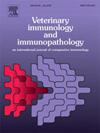Assessment of an indirect fluorescent antibody test for the detection of antibodies specific for Pajaroellobacter abortibovis in adult cattle
IF 1.4
3区 农林科学
Q4 IMMUNOLOGY
引用次数: 0
Abstract
A highly specific, sensitive, and reproducible indirect immunofluorescent antibody test (IFAT) capable of detecting antibodies bound to Pajaroellobacter abortibovis was previously described and validated for use with bovine fetal fluid. Similar validation has not been demonstrated with cow sera. Adult cattle show no sign of infection with P. abortibovis prior to abortion and therefore it is difficult to identify exposed animals. To address this problem, paired sera from 107 dams, that had lost calves due to EBA, were tested by the P. abortibovis-specific IFAT. Specificity and sensitivity were determined by comparing IFAT antibody titers before P. abortibovis exposure to those at or near the time of EBA abortion. Fifty-six samples from a combination of experimental negative controls and animals originating from non-endemic areas were added to increase the sample size when calculating specificity. None of the 107 sera collected from cows prior to Pajaroellobacter abortibovis exposure had detectable IFAT titers (i.e. <200), nor did sera from non-endemic (n = 46) and negative control cows (n = 10). In contrast, P. abortibovis-specific antibodies titers of ≥ 200 were detected in all 107 serum samples collected at or near the time of an EBA abortion. Specificity and sensitivity for dam sera were both established at 100 % when cutoff criteria for positive tests were assigned a titer of ≥ 200. This P. abortibovis-specific IFAT is a powerful tool for identifying exposure to the etiologic agent of epizootic bovine abortion in adult cattle and will facilitate future studies to better define the geographic distribution of the disease.
一种间接荧光抗体检测方法在成年牛中检测流产pajarolobacter特异性抗体的评价
一种高度特异、敏感和可重复的间接免疫荧光抗体试验(IFAT)能够检测与流产pajarolobacter结合的抗体,此前曾描述并验证用于牛胎液。类似的验证尚未在牛血清中得到证实。成年牛在流产前未表现出感染流产假单胞杆菌的迹象,因此很难识别暴露的动物。为了解决这个问题,来自107头因EBA而失去小牛的小牛的配对血清被P. abortibovis特异性IFAT测试。通过比较流产假单抗暴露前与流产时或流产前后的IFAT抗体滴度来确定特异性和敏感性。在计算特异性时,增加了56份来自实验阴性对照和来自非流行地区的动物的样本,以增加样本量。在暴露于流产pajarololobacvis之前收集的107份奶牛血清中没有检测到IFAT滴度(即<;200),非地方性(n = 46)和阴性对照奶牛(n = 10)的血清也没有检测到IFAT滴度。相比之下,在EBA流产时或流产前后收集的107份血清样本中,均检测到P. abortibovis特异性抗体滴度≥ 200。当确定阳性试验的截止标准滴度≥ 200时,对大坝血清的特异性和敏感性均为100 %。这种流产假单抗特异性IFAT是一种强大的工具,可用于确定成年牛的家畜流产病原暴露情况,并将促进未来的研究,以更好地确定该疾病的地理分布。
本文章由计算机程序翻译,如有差异,请以英文原文为准。
求助全文
约1分钟内获得全文
求助全文
来源期刊
CiteScore
3.40
自引率
5.60%
发文量
79
审稿时长
70 days
期刊介绍:
The journal reports basic, comparative and clinical immunology as they pertain to the animal species designated here: livestock, poultry, and fish species that are major food animals and companion animals such as cats, dogs, horses and camels, and wildlife species that act as reservoirs for food, companion or human infectious diseases, or as models for human disease.
Rodent models of infectious diseases that are of importance in the animal species indicated above,when the disease requires a level of containment that is not readily available for larger animal experimentation (ABSL3), will be considered. Papers on rabbits, lizards, guinea pigs, badgers, armadillos, elephants, antelope, and buffalo will be reviewed if the research advances our fundamental understanding of immunology, or if they act as a reservoir of infectious disease for the primary animal species designated above, or for humans. Manuscripts employing other species will be reviewed if justified as fitting into the categories above.
The following topics are appropriate: biology of cells and mechanisms of the immune system, immunochemistry, immunodeficiencies, immunodiagnosis, immunogenetics, immunopathology, immunology of infectious disease and tumors, immunoprophylaxis including vaccine development and delivery, immunological aspects of pregnancy including passive immunity, autoimmuity, neuroimmunology, and transplanatation immunology. Manuscripts that describe new genes and development of tools such as monoclonal antibodies are also of interest when part of a larger biological study. Studies employing extracts or constituents (plant extracts, feed additives or microbiome) must be sufficiently defined to be reproduced in other laboratories and also provide evidence for possible mechanisms and not simply show an effect on the immune system.

 求助内容:
求助内容: 应助结果提醒方式:
应助结果提醒方式:


